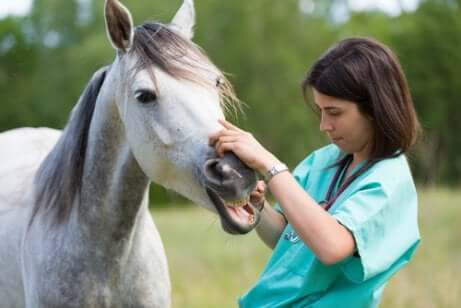5 Tips to Combat Skin Problems in Horses


Written and verified by the lawyer Francisco María García
Rashes and skin problems are among the most common diseases in horses. These conditions can seriously damage the animal’s quality of life. They can also create permanent health damage. It’s important to know how to prevent skin problems in horses so that you can offer optimal preventative care.
Next, we’ll talk about the main skin problems in horses and their symptoms.
The most common skin problems in horses
In general, conditions affecting a horse’s skin are caused by parasites and pathogenic microorganisms. They are associated with imbalances in their environment or failure to use appropriate preventive medicine.

Scabies on horses
Scabies is a highly contagious skin disease that can affect different species of animals, including humans. The condition is caused by small arachnids, which are popularly known as mites.
At present, there are different types of scabies that affect horses. The following are the three that are more frequently diagnosed:
Types of scabies in horses
- Sarcoptic mange: This type causes hair loss and small bumps on the skin, which cause intense itching. These symptoms usually start on the head and neck. They rapidly begin to affect the back and rump of the horse as well. The cause of this type of scabies is the Sarcoptes mite. If not treated in time, this can lead to anorexia and anemia.
- Psoroptic mange: This type mainly affects joints and areas with longer hair. Itching is the main symptom. It is caused by the Psoroptes mite.
- Chorioptic scabies: Also known as foot or leg mange, it mainly affects the hindquarters and hooves. The most characteristic symptom of this type of scabies it that horses will hit the ground frequently to help relieve itching.
Ringworm in horses
Ringworm is an infectious disease that comes from a fungus. It mainly affects the horse’s skin. In general, this disease takes advantage of an immunological deficiency in the animal. In other words, it tends to be more frequent in elderly horses or those that don’t receive adequate preventive medicine.
The most characteristic symptom of ringworm in horses are circular lesions accompanied by alopecia. If not treated quickly, yellow scabs form on the wounds. These scabs give off a peculiar, unpleasant odor.
Mites and fungi on horses
The two diseases mentioned are some of the problems caused by mites and fungi. There are, however, many rashes and infections that mites and fungi can cause in horses.
Typically the spread of fungi and mites comes from poor conditions in a horse’s environment. These allow, for example, the accumulation of moisture and dirt on the animal’s skin and hair. They can also alter the skin’s pH.
On the other hand, incomplete nutrition and inadequate preventive medicine can also weaken the equine immune system. As a result, their bodies are then more vulnerable to all kinds of diseases and skin problems in horses.

5 tips to prevent skin problems in horses
These tips can help you prevent skin problems in horses:
- Take care of your horse’s environment. Your horse’s stables should provide optimum conditions for their development. Good ventilation and light are essential to avoid the proliferation of microorganisms and parasites.
- Give them complete and balanced nutrition. Poor quality hay or hay of unknown origin can become moist easily. It also may contain so-called ‘straw itch mites.’ Good nutrition is key to strengthening the horse’s immune system.
- Grooming. Daily grooming and cleaning are essential to maintain the beauty and health of your horse’s skin and coat. This routine can also help detect early symptoms of skin problems in horses, as well as the presence of parasites.
- Cleanliness. You should also clean your horse’s stable regularly. You should pay special attention to avoid the accumulation of any leftover food, wet hay, or dirt. It’s also essential to wash the trough of the horses every day. That way, you can avoid the water becoming stagnant or dirty.
- Preventive medicine. Similar to dogs and cats, horses need to meet a schedule of vaccines and deworming to prevent serious diseases that could lead to death or irreparable damage. We also recommend that they see a vet at least twice a year.
Rashes and skin problems are among the most common diseases in horses. These conditions can seriously damage the animal’s quality of life. They can also create permanent health damage. It’s important to know how to prevent skin problems in horses so that you can offer optimal preventative care.
Next, we’ll talk about the main skin problems in horses and their symptoms.
The most common skin problems in horses
In general, conditions affecting a horse’s skin are caused by parasites and pathogenic microorganisms. They are associated with imbalances in their environment or failure to use appropriate preventive medicine.

Scabies on horses
Scabies is a highly contagious skin disease that can affect different species of animals, including humans. The condition is caused by small arachnids, which are popularly known as mites.
At present, there are different types of scabies that affect horses. The following are the three that are more frequently diagnosed:
Types of scabies in horses
- Sarcoptic mange: This type causes hair loss and small bumps on the skin, which cause intense itching. These symptoms usually start on the head and neck. They rapidly begin to affect the back and rump of the horse as well. The cause of this type of scabies is the Sarcoptes mite. If not treated in time, this can lead to anorexia and anemia.
- Psoroptic mange: This type mainly affects joints and areas with longer hair. Itching is the main symptom. It is caused by the Psoroptes mite.
- Chorioptic scabies: Also known as foot or leg mange, it mainly affects the hindquarters and hooves. The most characteristic symptom of this type of scabies it that horses will hit the ground frequently to help relieve itching.
Ringworm in horses
Ringworm is an infectious disease that comes from a fungus. It mainly affects the horse’s skin. In general, this disease takes advantage of an immunological deficiency in the animal. In other words, it tends to be more frequent in elderly horses or those that don’t receive adequate preventive medicine.
The most characteristic symptom of ringworm in horses are circular lesions accompanied by alopecia. If not treated quickly, yellow scabs form on the wounds. These scabs give off a peculiar, unpleasant odor.
Mites and fungi on horses
The two diseases mentioned are some of the problems caused by mites and fungi. There are, however, many rashes and infections that mites and fungi can cause in horses.
Typically the spread of fungi and mites comes from poor conditions in a horse’s environment. These allow, for example, the accumulation of moisture and dirt on the animal’s skin and hair. They can also alter the skin’s pH.
On the other hand, incomplete nutrition and inadequate preventive medicine can also weaken the equine immune system. As a result, their bodies are then more vulnerable to all kinds of diseases and skin problems in horses.

5 tips to prevent skin problems in horses
These tips can help you prevent skin problems in horses:
- Take care of your horse’s environment. Your horse’s stables should provide optimum conditions for their development. Good ventilation and light are essential to avoid the proliferation of microorganisms and parasites.
- Give them complete and balanced nutrition. Poor quality hay or hay of unknown origin can become moist easily. It also may contain so-called ‘straw itch mites.’ Good nutrition is key to strengthening the horse’s immune system.
- Grooming. Daily grooming and cleaning are essential to maintain the beauty and health of your horse’s skin and coat. This routine can also help detect early symptoms of skin problems in horses, as well as the presence of parasites.
- Cleanliness. You should also clean your horse’s stable regularly. You should pay special attention to avoid the accumulation of any leftover food, wet hay, or dirt. It’s also essential to wash the trough of the horses every day. That way, you can avoid the water becoming stagnant or dirty.
- Preventive medicine. Similar to dogs and cats, horses need to meet a schedule of vaccines and deworming to prevent serious diseases that could lead to death or irreparable damage. We also recommend that they see a vet at least twice a year.
All cited sources were thoroughly reviewed by our team to ensure their quality, reliability, currency, and validity. The bibliography of this article was considered reliable and of academic or scientific accuracy.
- intermedica.com. Dermatología equina. Extraído de: http://www.intermedica.com.ar/media/mconnect_uploadfiles/s/c/scott.pdf
- J. A. Cardona, M. Vargas-Viloria, S. Perdomo. 2013. FRECUENCIA DE PYTHIOSIS CUTÁNEA EN CABALLOS. Extraído de: http://www.scielo.org.co/pdf/rfmvz/v61n1/v61n1a04.pdf
This text is provided for informational purposes only and does not replace consultation with a professional. If in doubt, consult your specialist.








